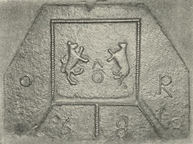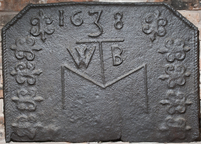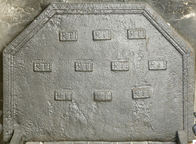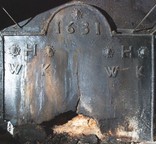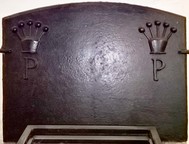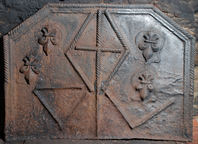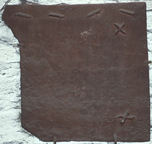-
897
Description: Steeply canted rectangle; no edging; upper centre, square formed of twisted rope lengths inside which are what appear to be two lions passant in pale with a circle and two short sloping lines in inverted V form above; on either side of the square is an O and an R; below the square three lengths of twisted rope extend to the bottom edge, the central one vertically and the the outer two sloping away from the centre; along the bottom is the date, each numeral separated by one of the rope lengths.
Notes: Alleged to be a representation of the arms of the O'Rourke family, who held sway in Cavan and Leitrim, the initials said to be of Owen O'Rourke. Noted in a cottage at Arigna, County Roscommon.
Inscription: O O R / 1 6 8 8
Arms: O'Rourke
- Decoration tags:
- rectangular with canted top corners (shape)
- none (edging)
- simple stamps
- carved stamps
- heraldic
- text
- animals
- objects
Manufactured: in 1688 possibly at Drumshanbo Furnace in the Leitrim area of Ireland.
Current location: not known.
Citation: Lindsay, J. S., 1927, Iron & Brass Implements of the English House (London, The Medici Society).
- Attached to series:
- Miscellaneous stamp firebacks
-
1242
Description: Canted rectangular shape; twisted rope edging (top and sides); top centre, date, 1638, with uneven figures (oversize 3), between two fleurs-de-lys; four fleurs-de-lys, lying horizontally, down each side; below date, slender 'T' shape above a slender 'M' shape, with initials 'W' and 'B' separated by the 'T' shape.
Notes: The distinctive fleur-de-lys has not been noted on any other fireback. Purchased by Birmingham Museums in 1982 at the sale of the contents of the house ‘Hildercroft’ on Highfield Road in Hall Green, Birmingham.
Inscription: 1638 / W T B / M
- Decoration tags:
- rectangular with canted top corners (shape)
- rope (edging)
- simple stamps
- carved stamps
- heraldic
- text
- objects
Manufactured: in 1638 in England.
Current location: Blakesley Hall, Blakesley Road, Yardley, West Midlands, England.
(part of the Birmingham Museums Trust museum group)
- Attached to series:
- Miscellaneous stamp firebacks
- Fleur-de-lys firebacks
-
876
Description: Canted rectangle; complex moulded edging (top and sides); rectangular incised initial stamp repeated ten times 3-4-3.
Notes: The use of an incised stamp is uncommon.
Inscription: RTI [repeated 10 times]
- Decoration tags:
- rectangular with canted top corners (shape)
- complex individual (edging)
- carved stamps
- text
Manufactured: in the 17th century in England.
Current location: Westwood Manor, Bradford-on-Avon, Wiltshire, England.
Museum number: 222509.1 (part of the National Trust museum group)
- Attached to series:
- Initials only firebacks
- Miscellaneous stamp firebacks
-
875
Description: Canted rectangle; double fillet edging (top and sides); repeated 'X' stamp parallel to edging, horizontally across centre, and in two parallel lines from top to centre, dividing top half of plate into three sections; 'daisy' stamp approximately in middle of top left and right sections, repeated four times in triad in top middle section, and thrice along top of bottom section; small roundel stamp repeated 3-3-1 in top left section, and 3-1-3-1 in top right section; date split between top left and right sections; initials split in top centre section.
Notes: An arrangement with several elements likely to have been repeated on other firebacks.
Inscription: 16 D[reversed] B 81
- Decoration tags:
- rectangular with canted top corners (shape)
- double fillet (edging)
- carved stamps
- heraldic
- text
- objects
Manufactured: in 1681 in the Forest of Dean area of England.
Current location: Westwood Manor, Bradford-on-Avon, Wiltshire, England.
Museum number: 222490 (part of the National Trust museum group)
- Attached to series:
- Newent area group
- Miscellaneous stamp firebacks
-
1028
Description: Arched rectangular shape; twisted rope edging (top and sides); date in arch; initial triads in top shoulders of plate; small mask patera repeated once above date and on each side of 'H' initials.
Notes: The small mask patera has not been seen on other firebacks.
Inscription: 1631 / WHK [triad] WHK [triad]
- Decoration tags:
- rectangular with round arch (shape)
- rope (edging)
- carved stamps
- individual letters
- individual numbers
- text
- objects
Manufactured: in 1631 in England.
Current location: The Lygon Arms, High Street, Broadway, Worcestershire, England.
- Attached to series:
- Miscellaneous stamp firebacks
-
1247
Description: Low-arched shape with bevelled edging (top and sides); in each top corner, capital letter 'P' below a stylised earl's coronet, the serif at the foot of the P facing outwards on each side of the fireback.
Notes: Evidently intended to relate to the property of, or commemorating, an earl; the earldom in question has not been identified.
Inscription: P P
- Decoration tags:
- rounded arched (shape)
- bevelled (edging)
- whole carved pattern
- heraldic
- text
Manufactured: in the 20th century in England.
Current location: in private hands, Broomfield, Somerset, England.
- Attached to series:
- Miscellaneous stamp firebacks
-
826
Description: Canted rectangular shape with moulded edging (top and sides) overlain by a length of twisted rope repeated six times; central vertical line formed of twisted rope, crossed with rope upper centre, with rope laid in a diamond pattern around the cross; lower centre, two irregular v-shapes formed of rope, one on each side of the vertical; shield shaped stamp with a fleur de lys repeated twice each side, upper left and right.
Notes: The twin V arrangement may have apotropaic significance and the cross above them having a Christian symbolism; the base board appears to have had a moulded edge, with rope lengths applied over part of the moulding after the board had been pressed into the casting bed; a sketch of this fireback was made by J. Starkie Gardner c.1891 and is in his collection at the Victoria and Albert Museum, Archive of Art and Design (AAD/2014/8).
- Decoration tags:
- rectangular with canted top corners (shape)
- rope over moulding (edging)
- simple stamps
- carved stamps
- heraldic
- apotropaic
- objects
Manufactured: in the late-16th century in the Weald area of England.
Current location: in private hands, Burwash, East Sussex, England.
- Attached to series:
- Miscellaneous stamp firebacks
- Rope design firebacks
- Fleur-de-lys firebacks
-
31
Description: Fragment; rectangular plate with series of parallelogrammatic billets arranged across the top; crossed billets in corners
- Decoration tags:
- rectangular (shape)
- none (edging)
- simple stamps
Manufactured: possibly in the Weald area of England.
Current location: in private hands Burwash, East Sussex, England.
- Attached to series:
- Miscellaneous stamp firebacks
-
223
Description: Rectangular; cavetto with double fillet edging; two side panels each separated by twisted rope, and each containing six fleurs de lys arranged vertically; top panel separated by twisted rope, containing inscription; central panel with lion’s head between two fleurs de lys.
Notes: A late example of the use of individual carved stamps; from Heol Ddu Isaf, Bargoed, acquired by the National Museum of Wales in 1922.
Inscription: WLA [triad] 1714 WLA [triad]
- Decoration tags:
- rectangular (shape)
- carved stamps
- individual letters
- individual numbers
- heraldic
- text
Manufactured: in 1714 possibly in the South Wales area of Wales.
Current location: National History Museum, St Fagans, Glamorgan, Wales.
Museum number: 21.31 (part of the Welsh National History Museum museum group)
- Attached to series:
- Miscellaneous stamp firebacks
-
1070
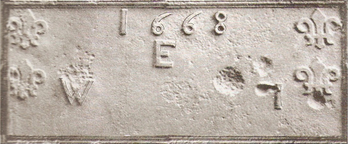 ? x ? mm
? x ? mmDescription: Rectangular; ovolo-moulded edging; two fleurs-de-lys arranged vertically top left and top right; top centre, date; below date, initials WEI in triad.
Notes: Said to have been made by George White, iron founder, of Monmouth. Formerly from Newport, Monmouthshire.
Inscription: 1668 / W E I [triad]
- Decoration tags:
- rectangular (shape)
- ovolo (edging)
- carved stamps
- individual letters
- individual numbers
- heraldic
- text
Manufactured: in 1668 possibly at Tintern Furnace in the Forest of Dean area of Wales.
Current location: National History Museum, St Fagans, Glamorgan, Wales.
Museum number: 25.21 (part of the Welsh National History Museum museum group)
Citation: Kissack, K., 2003, Monmouth and its Buildings (Almeley, Logaston Press).
- Attached to series:
- Miscellaneous stamp firebacks
